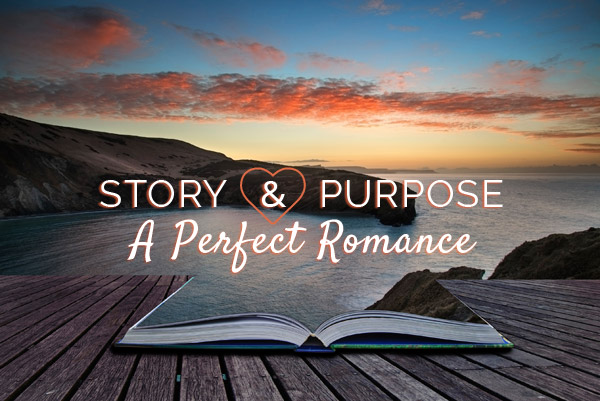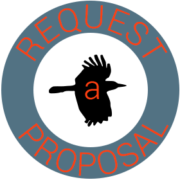Marrying Story To Purpose: A Perfect Romance
Everyone’s got a narrative up their sleeve. Anything can become a story.
But they are not all created equal in their potency or effectiveness. Nor will just any story told any-which-way enhance the delivery and a solid landing of your marketing message.
Which ones are worthy?
How will you tell yours in a way that supports the clarity of your message rather than dissipating or distracting from it?
Can you frame a story to fit your needs or will the story slyly attempt to make your needs fit it?
Inquiring Minds…
These are questions I’ve been asking myself while giving myself some hard knocks (upside my head) as I try to arrive at my own individually perfect personalized answers. Your answers will necessarily be different than mine, but I’ll share some of my thoughts and hopefully, they’ll be of use to you.
These are questions that should be routinely asked even if the answers are illusive.
Nothing New Here… Yet We Each Shape Our Own Twist
The use of storytelling in marketing isn’t a new convention or phenomenon. It’s a well-established and highly recommended form for good reason. This is primarily because it elicits an emotional response, a connection that allows us to tap into our humanity, our commonalities.
The act of recalling and sharing something that happened, that we’ve experienced or even a bit of suitable fiction enables our customers or clients to feel a sense of intimacy with us and our brand. Our brand story is created through all our behaviors and actions- everything our business represents and stands for, what we do both online and off.
Active storytelling, on the other hand, the act of deliberately highlighting or telling a story to enhance our content, is an added benefit that allows our readers to get to know us, to feel they have an inside scoop to what we’re about. They instigate the sense that we are speaking directly to them personally as individuals. Which we actually are.
Stories open our hearts. They help our readers learn what matters to us, how we regard the world around us and our place in it.
We learn concepts, lessons and values more readily through story, parable, analogy, folk tale, myth, anecdote. We utilize storytelling to make a point, to teach a philosophy, demonstrate a method, make a suggestion, offer encouragement and inspiration. They are entertaining and educational.
Why I love Telling Stories
Like so many others, I understand the power they hold but I also enjoy weaving them in to marry their heart and soul to my overriding message. It’s not that I have an over abundance of them, but when one occurs to me that illuminates a topic I feel is worth exploring, the process of storytelling is an exhilarating and satisfying creative experience.
In that process, there’s a singular kind of magic that occurs; I find myself entering into a delicious writing zone. One that opens up the edges and boundaries around a subject and allows my imagination to become lively and flourish. That internal energy seems to make its way into the piece and creates what I believe to be a more compelling, not so medicinal mix of informational absorption. Plainly put, it makes writing [and reading] what may potentially be dry marketing articles more fun and more digestible. And frankly, it helps me locate even deeper meaning and purpose than I might have. In turn, I hope that it encourages my readers to broaden their own interpretation and use of the material.
Walking That Skinny Precarious Line
How do we tread that fine line between allowing our creativity to percolate and steam while still managing to stay on track, give useful information, responsibly approach topics that require logic, sequence, clarity and actionable information?
It’s some part technique, some part structure, some part passion and another part freedom or flow. And then yet another part: alchemy.
Most distinctly, it’s remaining loyal to the topic and not allowing the juice of the creative process to distract us away from our purpose. [My personal temptation.]
Expanding The Horizon
There are some precedents for investigating the unexpected in writing for our business. Even in content marketing we can integrate the attitude, the mindset of Creative non-fiction.
“There are many ways to define the literary genre we call Creative Nonfiction. It is a genre that answers to many different names, depending on how it is packaged and who is doing the defining. Some of these names are: Literary Nonfiction; Narrative Nonfiction; Literary Journalism; Imaginative Nonfiction; Lyric Essay; Personal Essay; Personal Narrative; and Literary Memoir. Creative Nonfiction is even, sometimes, thought of as another way of writing fiction, because of the way writing changes the way we know a subject”. BarrieJean Borich, BarrieJeanBorich.com
“In some ways, creative nonfiction is like jazz—it’s a rich mix of flavors, ideas, and techniques, some of which are newly invented and others as old as writing itself..” Lee Gutkind, creativenonfiction.org
How can we best foster our creativity while simultaneously covering topics that are needed and used – concrete issues that are helpful to our clients and readers, work that can be of service? The goal.
[Tweet “Not being a convert to formulas, I have to resort to the case-by-case scenario. “]
Each article and each story commands its own direction and usage. As writers, we need to be sensitive to our own intentions and make sure we’re staying on track while still allowing space for the alchemy to occur. Something I am learning about as I type.
We can tell our stories and we should. And just like everything else with content marketing and building an online presence, we should always be mindful of our audience and what reading our stories will be like for them. Will it help brighten or muddy the waters? Ask that question each time just to make sure.
SUBSCRIBE & Receive Blog Notifications Of New Posts:
* Don’t miss any of our blog posts! Subscribe at the top right of the page.
Google Plus Post Notifications:
* Would you like to be included in my Google Plus Notification Circle?
If you would, please visit the invitation and let me know in the comments with a +mention of my name. Thanks!
Pre-Remix photo iStock Photo, Remix: Gina Fiedel







Hey Gina
We have never interacted on Google Plus, but I definitely wish to change my oversight!
You are a delightful, delicious and decadent storyteller #HUGSSSSS
Thanks for a wonderful article that gave me a glimpse into what makes YOU and how to create stories that meld our creativity with our intention.
BRILLIANT
Kitto